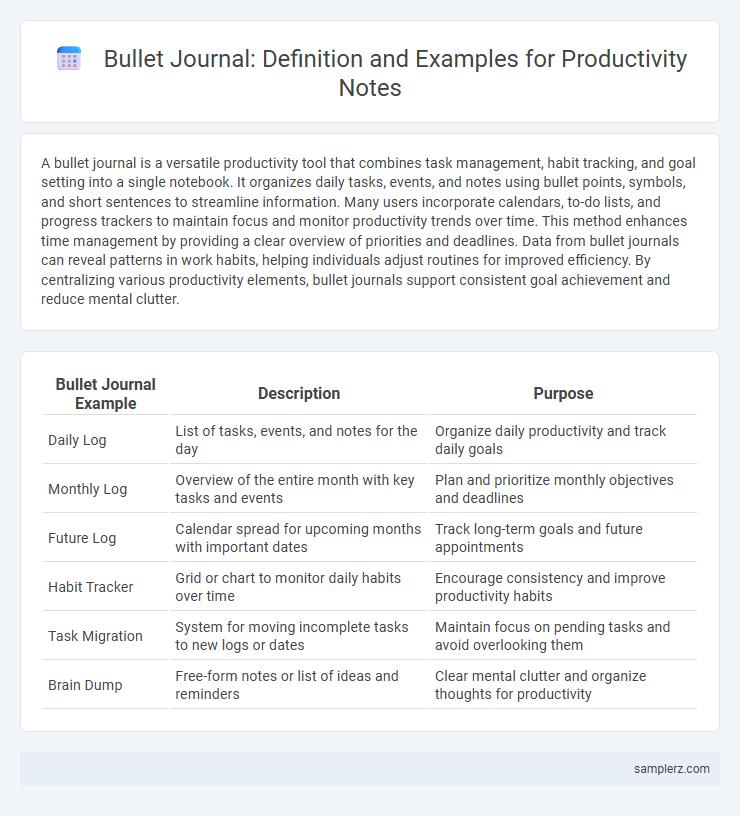A bullet journal is a versatile productivity tool that combines task management, habit tracking, and goal setting into a single notebook. It organizes daily tasks, events, and notes using bullet points, symbols, and short sentences to streamline information. Many users incorporate calendars, to-do lists, and progress trackers to maintain focus and monitor productivity trends over time. This method enhances time management by providing a clear overview of priorities and deadlines. Data from bullet journals can reveal patterns in work habits, helping individuals adjust routines for improved efficiency. By centralizing various productivity elements, bullet journals support consistent goal achievement and reduce mental clutter.
Table of Comparison
| Bullet Journal Example | Description | Purpose |
|---|---|---|
| Daily Log | List of tasks, events, and notes for the day | Organize daily productivity and track daily goals |
| Monthly Log | Overview of the entire month with key tasks and events | Plan and prioritize monthly objectives and deadlines |
| Future Log | Calendar spread for upcoming months with important dates | Track long-term goals and future appointments |
| Habit Tracker | Grid or chart to monitor daily habits over time | Encourage consistency and improve productivity habits |
| Task Migration | System for moving incomplete tasks to new logs or dates | Maintain focus on pending tasks and avoid overlooking them |
| Brain Dump | Free-form notes or list of ideas and reminders | Clear mental clutter and organize thoughts for productivity |
Introduction to Bullet Journaling for Productivity
Bullet journaling enhances productivity by combining task management, goal tracking, and reflection in a customizable analog system. Users create rapid logs, collections, and indexes tailored to prioritize daily tasks and long-term projects efficiently. This method fosters mindfulness and organization, helping individuals maintain focus and achieve better time management outcomes.
Key Components of an Effective Bullet Journal
An effective bullet journal integrates key components such as the index for quick navigation, rapid logging for efficient note-taking, and customizable collections tailored to specific tasks or projects. It employs concise bullets and signifiers to differentiate tasks, events, and notes, enhancing clarity and organization. Regularly updating the migration process ensures that incomplete tasks are prioritized, maintaining productivity and focus.
Essential Supplies for Bullet Journaling
Essential supplies for bullet journaling include a high-quality dotted or grid notebook, fine-tip pens in various colors for organization, and a ruler for clean, straight lines. Incorporating stickers, washi tape, and stencils can enhance creative layouts and visual appeal. Durable bookmarks and adhesive tabs help quickly access frequently referenced pages, boosting overall productivity.
Daily Log Example for Task Management
A bullet journal's Daily Log example enhances task management by breaking down the day into concise, actionable entries marked with bullets for tasks, events, and notes. Incorporating symbols like dots for tasks, circles for events, and dashes for notes enables quick visual categorization and prioritization. This method improves productivity by fostering clear organization and immediate tracking of completed or migrated tasks within a streamlined, personalized framework.
Weekly Spread Ideas for Organized Planning
Bullet journals enhance productivity through customizable weekly spreads that combine task lists, habit trackers, and priority sections for streamlined planning. Incorporating color-coded layouts and time-blocking techniques optimizes workflow and ensures balanced focus on deadlines and personal goals. Integrating reflection prompts within the weekly spread supports continuous improvement and effective time management.
Monthly Overview Sample for Goal Tracking
A bullet journal Monthly Overview sample for goal tracking typically includes clearly marked sections for each goal with specific deadlines and progress indicators. Tasks are broken down into manageable steps, allowing users to visualize monthly achievements and adjust priorities effectively. Color-coded symbols or habit trackers enhance clarity and motivate consistent productivity throughout the month.
Habit Tracker Layouts to Boost Productivity
Habit tracker layouts in bullet journals effectively enhance productivity by visually monitoring daily routines and progress. Incorporating grids or calendar-style spreads enables consistent tracking of habits such as exercise, hydration, and reading, promoting accountability. Color-coded symbols and progress bars further motivate habit formation and help identify patterns for targeted improvements.
Creative Collections for Project Management
Bullet journal creative collections enhance project management by organizing tasks, deadlines, and ideas in customizable formats. Examples include mood boards, progress trackers, and brainstorming grids, which visually map project stages and facilitate innovative problem-solving. These collections improve focus, streamline workflows, and boost productivity through tailored, engaging note-taking methods.
Tips for Customizing Your Bullet Journal
Customize your bullet journal by incorporating color-coded symbols to quickly categorize tasks, events, and priorities for enhanced visual organization. Use varied page layouts, such as calendars, habit trackers, and mood logs, tailored to your specific goals to boost productivity. Regularly review and adjust your key and collections to ensure the system remains flexible and aligned with your evolving needs.
Digital vs. Paper Bullet Journal: Pros and Cons
Digital bullet journals offer seamless organization with customizable templates and easy access across devices, enhancing productivity through quick edits and search functions. Paper bullet journals foster creativity and memory retention by engaging tactile senses and minimizing digital distractions, promoting mindfulness in task management. Choosing between digital and paper depends on individual workflow preferences, balancing convenience and personalization for optimal productivity.

example of bullet journal in note Infographic
 samplerz.com
samplerz.com